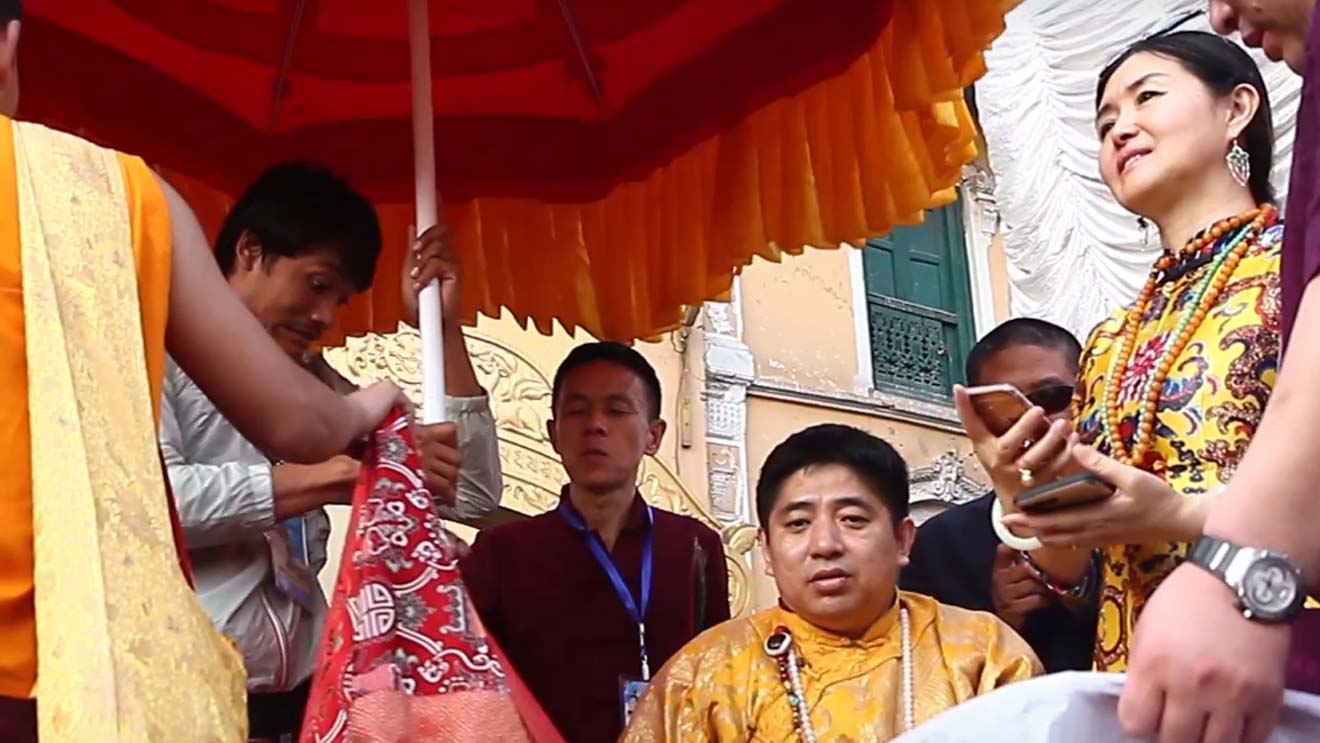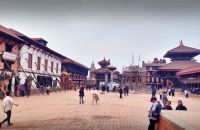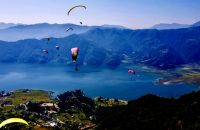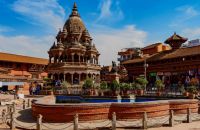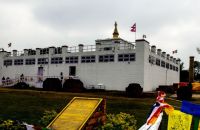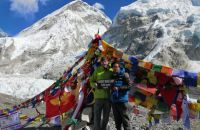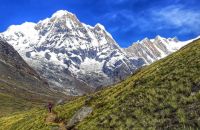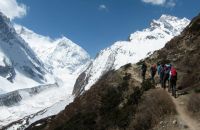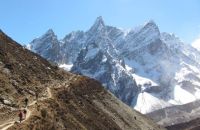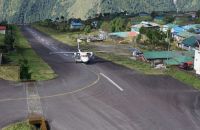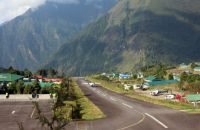Talk with our local travel specialist who can help organize your trip.
Festivals of Nepal - Spiritual and Vibrant
Nepal is a country rich in cultural heritage and vibrant festivals. The Nepalese calendar is filled with numerous festivals that are celebrated throughout the year. These festivals are testaments to Nepal's rich culture and diverse traditions. Among many festivals, Dashain with Tihar is one of the most popular festivals celebrated in September or October.
Dashain and Tihar span over twenty days and commemorates the victory of good over evil. During Dashain, which is 15 days festival, People worship the goddess Durga and visit their relatives, exchange gifts, and feast on delicious food. Tihar, also known as the "festival of lights," is a five-day-long festival that is celebrated in October or November. The third day of Tihar is the most special day when the goddess Laxmi is worshipped.
The colorful festivals of Nepal, be it Dashain, Holi or Teej, are vibrant and spiritual socio-religious celebrations. In Nepal, there is a festival for each season. With more than 120 ethnic groups populating its mountainous regions, Nepal is a melting pot of cultures. Though Hinduism and Buddhism are the two major religions in the country, each ethnic group has its own special festival.
Similarly, Holi is another popular festival celebrated throughout the country. Also known as the "festival of colors," Holi is celebrated in March or April. The specialty of this festival is that people smear colored powder, throw water balloons, and dance to traditional Nepali music. This festival signifies the victory of good over evil and brings people together.
Additionally, Teej is a women-special vibrant festival celebrated in August or September. Gai Jatra, Ram Navami, Shiva Ratri, Chhat, and Indra Jatra are other festivals celebrated with great enthusiasm and zeal in Nepal. Festivals are an integral part of Nepal's culture and they bring happiness and a sense of togetherness among the Nepali people. The festivals are an excellent opportunity to gain insight into Nepal's culture and traditions.
Table of Content
Dashain
Somewhere in Late September to early October people of Nepal indulge in the biggest festival of the year- Bijaya Dashami. Throughout Nepal, people of all caste and creed come together to celebrate this 15-day long festival with much pomp and show. Dashain celebrates the victory of good over evil. Legend has it that Goddess Durga killed the terrible demon Mahisasur and freed the earth from evil.
The markets are filled with shoppers buying new clothes, gifts and luxuries. All the houses are cleaned and painted and relatives are invited to the celebration. Thousands of sheep, goats and water buffaloes are sacrificed as an offering to the goddess and every family feasts and celebrate with great joy and pride. On the final day, youngsters take ‘tika’, ‘jamara’ and blessings from their elders.
Tourists visiting Nepal during this period will get to live and experience one of the major Nepali festivals. Experience this wonderful festival with our Kathmandu Heritage sites Tour.
Tihar
Tihar is celebrated somewhere in between the months of October and November. Known as the festival of lights, the five-day-long festival is dedicated to Goddess Laxmi (the ‘Goddess of Wealth and Prosperity). Nepalese people clean their houses, beautiful decorations are made and oil lamps are lit in the traditional way. This is done with anticipation that Goddess Laxmi will visit their homes and bless them.
The festival also honors animals like crows, cows, and dogs as they have a deep significance in our day-to-day life. During the last day of the festival, all brothers are worshipped by their sisters with five-colored ‘tika’ and floral garlands. The brothers in return promise to protect them from life. Tourists visiting Nepal during this period are sure to be awed by the bright lights and celebrations.
Holi Or Fagu Purnima
Holi or Fagu Purnima is the festival of colors celebrated widely in Nepal. It usually falls on the full moon day in the Nepali ‘Fagu’ month (February to March in the solar calendar) and usually lasts for about two days. Holi is one of the most awaited festivals in Nepal and is celebrated with much enthusiasm and bright colors.
The spring season in Nepal is that time of the year when many tourists from various countries come and visit Nepal. Most of these tourists are trekking enthusiasts and the rest come to soak in the country's history, culture, and heritage. If you visit Nepal during Holi, you will get to experience the festival of colors first hand, an experience like no other. It is definitely an experience like no other because it is the most enjoyable festival in all of Asia. If you are planning to be here during this festival, you could choose our Kathmandu Heritage site tours to make the most out of your Holi experience.
According to Legend, in ancient days, there was a devil king named Hiranyakashyap. The demonic king had earned 5 special powers as a boon: a human being or an animal could never kill him. He couldn’t be killed in night or day, neither by projectile weapons or handheld weapons. He couldn’t be killed on land, water or air.
He thought he was God and grew arrogant. He was so arrogant that he did not allow anybody in his kingdom to worship Vishnu; instead they were made to worship him. His son, prince Prahlad was a true devotee of Vishnu and he prayed to him every day in spite of his father’s threat. Knowing that his own son was defying his orders, King Hiranyakashyap decided to kill his son, prince Prahlad.
On a full moon night the king ordered his sister Holika who had magical powers sit on a pyre with Prahlad. Holika was wearing a magical cloak and remained immune from fire. Prahlad did not have any protection as such but his devotion to Vishnu was so strong that magically the fireproof cloak flew from Holika and encased the precious body of Prahlad saving him and killing Holika.
After the incident, Vishnu appears in the form of ‘Narasimha’- half human and half lion. Narasimha took the king on the door step, which was neither indoors or outdoors, placed him on his lap, which was neither air, land or water and killed the king with his lion claw, neither a projectile nor a handheld weapon.
In Kathmandu, the arrival of Holi is signified after the ‘Chir’ a wooden pole is erected in the Basantapur area at least a week prior to Holi. People start preparing in advance and one can already see people start to play with water and colors, especially children. On the day of the festival, thousands of people gather at crossroads and start throwing color and water at each other. One day, everybody comes together to play with various colors and enjoy each other’s company.
The energetic crowd moves from one place to another applying color to their friends and even to those who they have never met in their life. There are no strangers today and everyone is unified because of one festival. From a bird’s eye view, it looks like a river of colors moving in all directions.
People who do not like to mix with the crowd stay back home and throw buckets of water from their terraces to the passing crowd. If this happens on any other day, one would probably be very angry, but you will find locals screaming merrily ‘Happy Holi’ even if you wet them with water.
On this day, the tourists who go outdoors are sure to return back full of color and wet from top to bottom. You will also find music and dance in almost any neighborhood of the country. One day, everyone puts aside their differences and come together to celebrate the festival of colors.
Buddha Jayanti
Nepal is a multicultural and multi-religious country. There are many festivals and special occasions that are celebrated in the country with much joy and happiness. Buddha Jayanti or Buddha Purnima is one of the important days where the birth of the ‘Light of Asia’ is celebrated.
The festival usually falls on the first full moon day of the first month of the Nepali calendar - Baisakh. It usually falls on May or April, which are also the perfect months to visit Nepal. If you are in Nepal at this point of time, you can definitely opt for the Kathmandu heritage site tour. This particular tour will take you to important Buddhist sites in Kathmandu Valley.
Siddharth Gautama was the son of King Suddhodhana and Queen Mayadevi of Kapilvastu. He later attained enlightenment and came to be known as Gautam Buddha. According to Legend, Siddhartha’s mother saw a white elephant with six tusks entering her body. As per the traditional approach of giving birth in the parent’s house, Mayadevi left Kapilvastu and headed to her parent’s house. On the way she suffered labor pain and the child was born in Lumbini under the shade of a tree. It is believed that as soon as Siddhartha was born, he announced that it was his last rebirth and took seven steps. At every step he took, a lotus bloomed.
When Siddhartha the prince was born, a renowned astrologer told the king that the prince would either be a great emperor who would conquer the world or he would leave everything behind and become a great sage and teacher. Hearing this, his father decided that his son would definitely be a great king, thus that day forward; Siddhartha grew in the comfort of his palaces and was kept away from all other worldly sufferings.
One day, as fate would have it while he was on a ride around the village, he saw three things that changed his life forever; he saw an old man, a diseased person and a dead person. Having seen things that he had never seen before, he started questioning why human beings suffer and what he could do to eliminate these sufferings. At the age of 29, Siddhartha Gautama left his son, wife and parents and headed into the woods to find answers to his questions.
After leaving behind the luxury of his palace, the prince started to move from one place to another, meditating and searching for wise men that could help him find the answers he was looking for. Finally while meditating under the Bodhi tree, Siddhartha Gautama achieved enlightenment and became ‘The Buddha.’ He started teaching and spreading the knowledge he had attained from years of penance and soon the word of Buddha started to spread all over Asia.
Buddha Jayanti or Buddha’s birthday is celebrated with much joy all around the globe. On this day Buddhists dress in white and offer food, fruits, flowers and candles to the Buddha. Animals that are kept in cages are freed to show compassion to all sentient beings. Food, water and cash is distributed to the old and the poor, with the aim of helping the weaker people of the society.
In Nepal, Buddha Jayanti is a national holiday and animal sacrifice is banned on this day. All the important Buddhist shrines like Swayambhunath, Boudanath etc. are decorated and prayers are offered for prosperity and well-being of all life. In Lumbini, which is the birthplace of Buddha, Mayadevi Temple is beautifully decorated and illuminated with colorful lights. The statue of Buddha is kept in a chariot and a procession is carried out. The monks chants mantras and even give a sermon on the life and teachings of Buddha.
If you are interested in Buddhism and keen on doing a religious tour to Nepal and Bhutan, we may have just the right package that may suit your needs and requirement. Our Nepal and Bhutan Buddhist pilgrimage tour is designed to take you to the sacred Buddhist pilgrimage sites.
Mahashivratri
Mahashivratri or the ‘Night of the Shiva’, is dedicated to one of the three main gods in the Hindu pantheon, Lord Shiva. Observed in the month of Magh (January/February), Mahashivratri celebrates the sacred union of Lord Shiva and Goddess Parvati. The day is also observed to pay homage to Lord Shiva for saving mankind by swallowing the poison released during the ‘Amrit manthan’(churning of the ocean by the demons to get ambrosia).
Devotees celebrate this auspicious day by fasting, meditating, visiting the shrines of Lord Shiva and bathing the Shivalinga with milk and honey. Devotees stay awake all night chanting mantras in honor of the Hindu god.
In Kathmandu, people throng to Pashupatinath Temple to pay homage to the god. The temple of Pashupatinath is one of the holiest Shiva shrines in the world. Hindu pilgrims from India and other countries make it a point to visit this temple on this day.
Hindu ascetics or sadhus with dreadlocks and bodies smeared in ash take out a procession. The air is thick with cannabis smoke as the sadhus smoke pot with gay abandon. The celebration reaches its climax at midnight when Lord Shiva is believed to appear before his devotees. The devotees sing devotional songs and chant mantras praising the god. It is an uplifting spiritual experience where one feels a spiritual oneness with the divine.
Janai Purnima
Janai Purnima is a full moon festival celebrated in the month of Shravan (July/August). On this day the Brahmins change their sacred thread by shaving their heads, fasting and taking a bath at a sacred water source (ponds or rivers guarded by Hindu deities). Hindu priests tie the wrists of Hindus with a ‘raksha bandhan’ or protective string.
This day is also special for Dhamis and Jhankris (shamans or spiritual healers) also. Rites and rituals are performed to pay homage to their spiritual guides. The new shamans also get initiated to the fold on this auspicious day.
In Kathmandu, devotees flock to the pond at Kumbeshwar Mahadev Temple at Patan Durbar Square for a sacred dip. Those who are deeply religious make it a point to trek to Gosainkunda Lake to take a purification dip on this day. The Gosainkunda Lake is filled with shamans dancing and Brahmins and other Hindu devotees taking a purification dip. The whole ambience is deeply spiritual and sacred.
Teej Or The Festival Of Wom
Teej is a colorful festival celebrated by Hindu women. During the festival, which stretches for three days, married women visit their maternal home and fast for their husbands' long life. Their male relatives invite the ladies for a feast (Dar). Attired in colorful outfits of red, green and yellow (the colors of fertility) the women sing and dance at their homes, temples and streets.
The next day they fast and visit temples dedicated to Lord Shiva praying for the well-being of their husbands. The unmarried girls pray for their husbands-to-be. On the last day the ‘Sapta Rishis’ or the ‘Seven Sages’ are worshipped and offerings are made after taking a purification bath with mud.
In Kathmandu, women queue up at the Pashupatinath Temple to pay homage to Lord Shiva. Women attired in red saris sing and dance outside the temple with their friends. For photographers, the festival offers a great opportunity to capture shots of this unique festival celebrated by only women.
- Written by: Naba Raj Amgai
- Updated: Tuesday Feb 2, 2021

